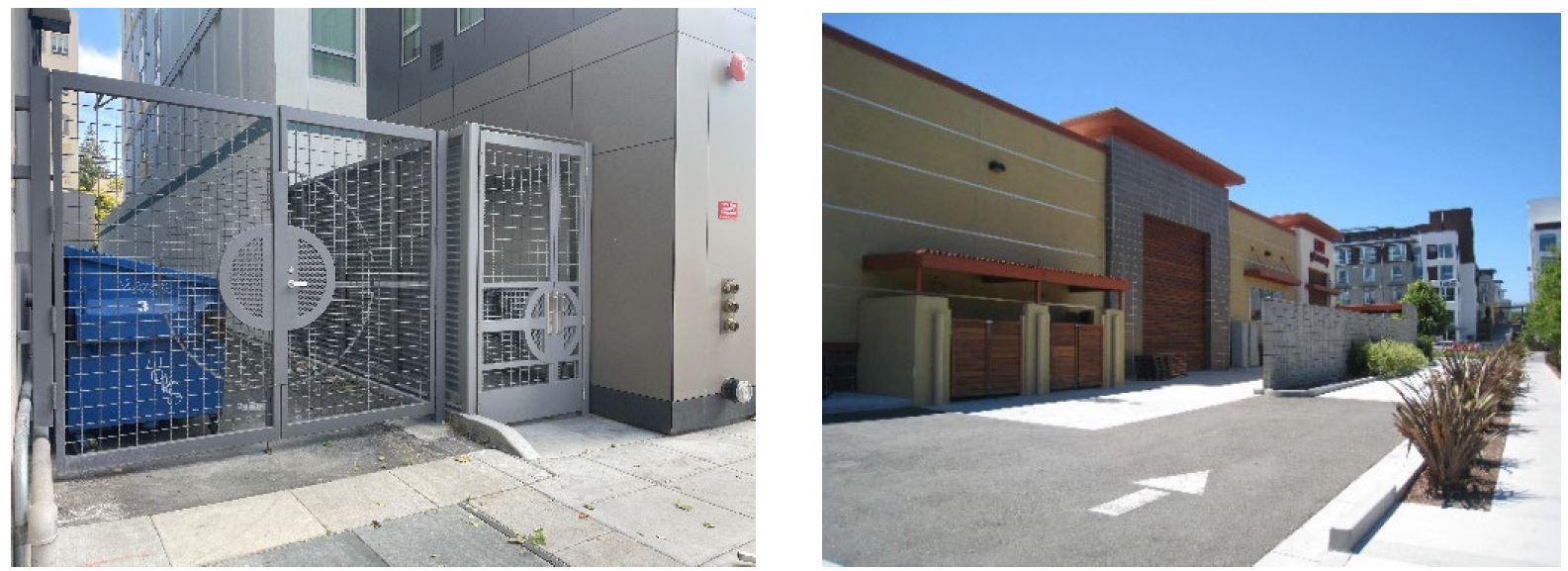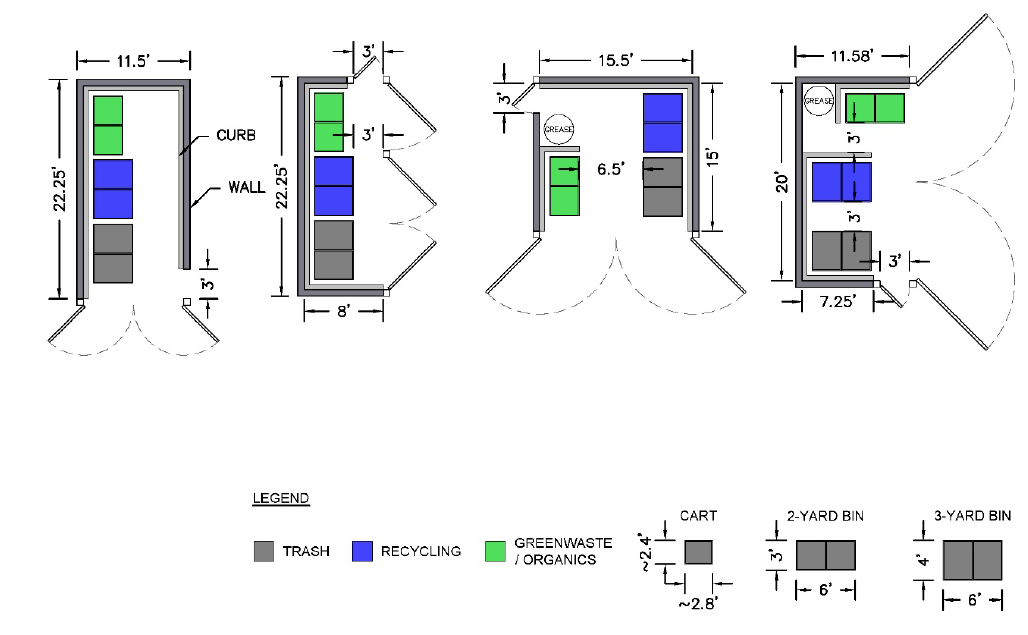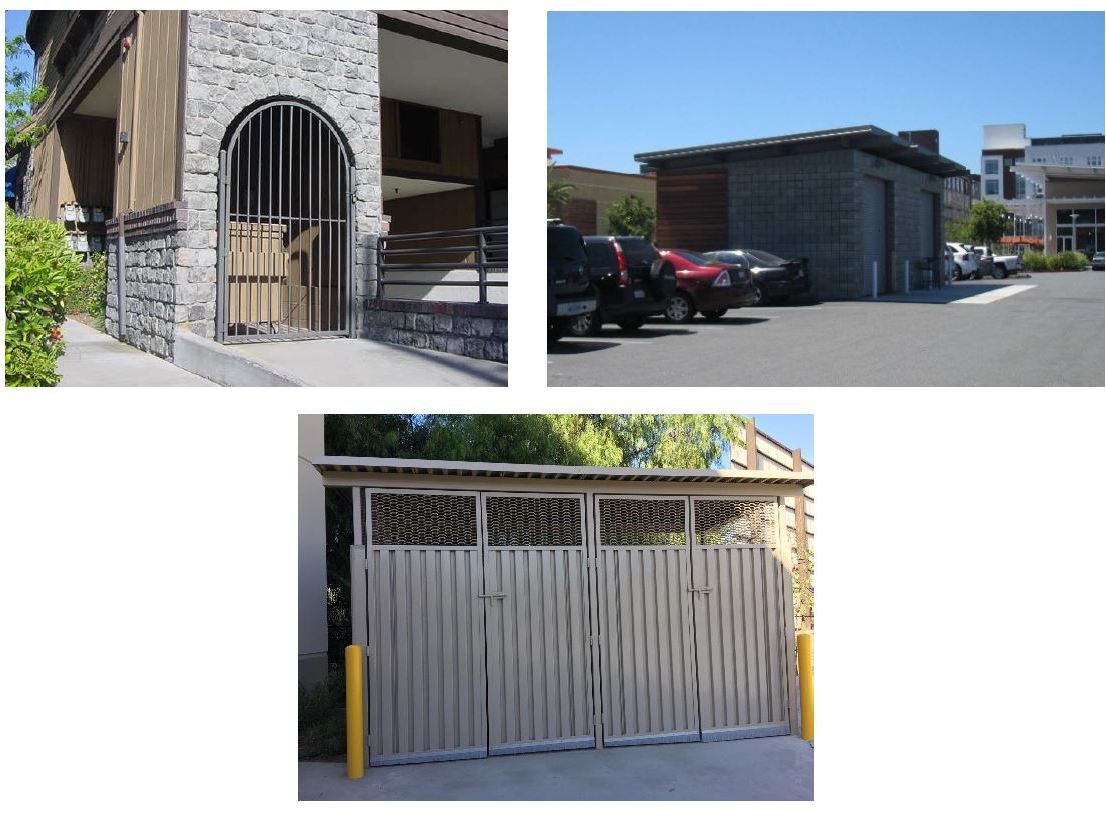Chapter 17.85
UTILITIES AND SERVICES
Sections:
17.85.010 Utilities, service areas, and building equipment.
17.85.020 Refuse and recycling.
17.85.010 Utilities, service areas, and building equipment.
(A) Undergrounding of Utilities.
(1) All new utility lines 50 kV and less, utility boxes, and utility equipment within a project and along adjacent regional and crosstown streets shall be placed underground pursuant to PMC Chapter 12.04 (Underground Utilities) unless otherwise prohibited by the utility provider (e.g., water backflow prevention device that must be placed above ground) or the City Engineer grants an exemption following his/her/their determination that such undergrounding is not practicable.
(2) Exception.
(a) In industrial zones, and for public/institutional development consistent with industrial zones, the Review Authority may reduce, waive, or defer requirements for utility line undergrounding and utility equipment screening, pursuant to PMC Chapter 12.04 (Underground Utilities) for portions of buildings not visible from regional and crosstown streets, and less intensive zones; and provided, that such action is determined to have no adverse effects. Additionally, for infill industrial projects in substantially developed industrial zones where utility lines have not been placed underground within the vicinity of the site, the City Engineer may defer utility line undergrounding requirements until such time as lines in the general area are undergrounded.
(b) In industrial zones, and for public/institutional development consistent with industrial zones, the requirement for undergrounding of utility lines may be waived for remodeling of existing structures where the cost of remodeling is less than 50 percent of the replacement cost of the existing structure as determined for building permits.
(B) Location of Service Areas, Storage, Utilities, and Equipment. All aboveground utilities and equipment (e.g., electric and gas meters, fire sprinkler valves, irrigation backflow prevention devices, etc.), service areas, and storage areas shall be integrated into building and landscape design and located to minimize impact on the pedestrian experience and neighboring properties by following the standards below:
(1) Utilities and equipment, service, storage, and nonpassenger loading areas shall be located inside of buildings or on nonprimary street frontages, alleys, parking areas, and/or at the rear or side of buildings and shall be fully screened from view per Subsection (C) of this Section (Service, Storage, Utility, and Equipment Screening).
(2) Utilities and equipment, service, storage, and nonpassenger loading areas shall not be located within setback areas, along midblock pedestrian connections, within the public right-of-way, and/or within 25 feet of a street corner.
(3) Except as otherwise required for fire safety as determined by the Director, roof ladders shall only be installed inside the associated building.
(C) Service, Storage, Utility, and Equipment Screening. All service and storage areas, utilities, and equipment not housed inside buildings shall meet the following screening standards:
(1) Screening shall be equal to or higher than the height of the equipment to be screened, unless specified otherwise.
(2) Screening shall be made of a primary exterior finish material used on other portions of the building, architectural grade wood or masonry, metal, or landscape screening that forms an opaque barrier when planted.
(3) Roll-up and service doors shall be painted to blend in with the main building colors and shall not face regional and crosstown streets. Where site constraints make the placement of these doors away from regional and crosstown streets infeasible, then doors shall be designed with glass or other architectural features to minimize visual impacts from the street, subject to approval by the Review Authority.
(4) Long-term shopping cart storage areas shall be completely screened. If screen walls are used, they shall be of sufficient height and length to screen all carts, and shall be made of a primary exterior finish material used on the main building, architectural grade wood or masonry, metal, or landscape screening that forms an opaque barrier when planted.
(5) All vents, flashing, electrical conduits, etc., shall be painted to match the color of the adjacent surface.
(6) The installation of gutters and downspouts on the exterior surface of new nonresidential buildings shall be prohibited.
(D) Location and Screening of Rooftop Equipment. Rooftop elements including roof access, mechanical equipment, and other features needed for the function of the building shall be located to minimize visual impact by meeting the following requirements. Mechanical equipment less than two feet in height, solar panels, wind generators, or green roof features shall be exempt from these requirements.
(1) Mechanical equipment shall be set back a minimum of 10 feet from the roof edge or screened with a parapet wall.
(2) Rooftop equipment shall be screened through the use of parapet walls, towers, or other architectural features such that it is not visible from any point at or below the roof level of the subject building (see Subsection (C) of this Section (Service, Storage, Utility, and Equipment Screening)).
(3) If equipment will be visible from adjacent taller buildings or from higher grades, it shall be painted to match the rooftop in color and should be grouped together where practical. (Ord. 1603 § 4 (Exh. I), 2023)
17.85.020 Refuse and recycling.
(A) Applicability. Any project for which an application for a building permit is submitted after the effective date of this Title shall include adequate, accessible areas for collecting and loading trash, recyclable materials, organic waste, and other refuse as required per State law. These regulations apply to refuse and recycling areas not accessible to the public, and which are used exclusively by the tenants/owners of the development site. The provisions of this Section apply to all development except as follows.
(1) Single-family or multifamily residential development projects that do not necessitate communal or shared refuse and recycling areas/containers. In such cases, no enclosure structure shall be required; however, individual trash, recycling, and green waste containers shall be stored in such a manner that containers are not visible or screened from public view from the front of the property. Containers may be placed in public view for purposes of collection.
(B) General Requirements.
(1) Trash, recycling, and organic waste containers and collection areas shall be adequate in capacity, number, and distribution to accommodate all waste generation of the site. An area for the storage of refuse/recycling shall be provided with minimum clear dimensions pursuant to Figure 17.85.020-1 (Refuse and Recycling Area Layout and Minimum Dimensions) for all multifamily residential uses, and for all nonresidential uses with a gross floor area of less than 25,000 square feet. At minimum, one such area shall be required. For larger projects, additional space(s) may be required as determined by the local waste management service provider based on the type of use, the size of the refuse area proposed, and the frequency of refuse collection. Enclosure size and configuration may be determined during development review for users with specialized requirements. Where practical, enclosures shall be sized to contain transformer boxes or other utility equipment which also requires screening.
Figure 17.85.020-1. Refuse and Recycling Area Layout and Minimum Dimensions
(2) Adequate and accessible enclosures for the storage of trash and recyclable materials shall be provided. An alternative to a trash/recycling enclosure shall include the placement of a bin in a concrete or metal lined pit. The use, location, design, construction, and accessibility of enclosures shall conform to the requirements in this Title, and shall be reviewed and approved by the Review Authority.
(3) When a site is retrofitted or upgraded to comply with refuse and recycling standards, the location of any new enclosures shall be reviewed by the local disposal service and approved by the Director.
(4) Solid waste collection areas shall not be used for storage or other purposes.
(5) To the extent feasible, refuse and recycling areas should be located adjacent to each other/within the same enclosure.
(C) Location.
(1) Refuse and recycling collection and trash compactor areas shall be located inside of buildings or inside of enclosures located along alleys or in parking areas at the rear or side of buildings. Refuse collection areas shall be prohibited within any required front setback, street side setback, any required parking spaces, landscape areas, and open space areas.
(2) Enclosures shall be located a minimum of 10 feet from any structure, 25 feet from any public street, 15 feet from a private street, and in nonresidential areas, 20 feet from any residentially zoned property.
(3) The location of enclosures shall not conflict with circulation or parking conditions on site. A condition shall not be created where a parked vehicle will obstruct access to an enclosure nor where a disposal truck will obstruct parked vehicles.
(4) Refuse and recycling enclosures shall be located in order to be easily accessible to refuse collection trucks and to site users. In general, distance from a building entry to the trash enclosure should not exceed 150 feet.
(D) Access. The storage area for refuse and recyclable materials shall be accessible to pedestrians (both residents and/or employees) of the development site and to refuse and recycling haulers. Vehicle access requirements shall be as follows:
(1) Driveways or travel aisles leading to exterior collection areas or enclosures shall be a minimum of 16 feet in width and paved pursuant to PMC § 17.87.090 (Parking design standards).
(2) Where driveways do not extend from street to street, a turnaround area for collection vehicles shall be provided. Minimum turning radius for collection vehicles shall be provided at 26/46 feet.
(3) Driveways or travel aisles shall provide unobstructed paved access for collection vehicles and provide a minimum of 15 feet vertical clearance. In loading areas, minimum overhead vertical clearance shall be 25 feet for loading operations.
(4) A concrete apron or pad, having a minimum size of 10 feet in width by 20 feet in length, shall be constructed in front of each exterior collection area or enclosure or trash compactor areas or at the point of pick-up by the collection vehicle. The purpose of this pad is to prevent damage to the surrounding asphalt paving. The pad shall have a level surface and shall be paved with concrete. The Director may waive the requirement for, and/or size of, the concrete apron or pad, provided the property owner can demonstrate that the existing asphalt located at the access and servicing areas of the refuse and recycling enclosure has withstood ongoing, regular use without appreciable degradation.
(E) Enclosures. Exterior collection areas shall be within an enclosure that meets the following standards:
(1) Minimum Height. Enclosures shall be adequate in height to fully screen containers and materials, with a minimum height of six feet.
(2) Design and Materials. Refuse/recycling enclosures shall be constructed of a primary exterior finish material used on other portions of the building, masonry, or decorative block, and may be accented with metal.
(3) Pedestrian Access. For multifamily residential developments, a pedestrian access and separate access for primary collection shall be provided.
(4) Roofing. A solid roof treatment that is architecturally compatible with the primary buildings on site shall be provided and shall be designed in a manner to prevent windblown trash from leaving the enclosure.
(5) Bins. All refuse and recycling shall be stored in metal containers to prevent it from being blown outside its walled enclosure by the wind. Lids must always remain closed except when loading or unloading.
(6) Gates. Solid metal self-closing gates painted to match the enclosure shall be required. All gates shall be post mounted. Gates shall be maintained in working order and shall remain closed except when in use.
(7) Protection from Bins and Vehicles. Concrete curbs, decorative bollards, or wheel stops shall be installed or constructed inside the enclosure to prevent bins from damaging the enclosure. Concrete curbs or equivalent shall protect the exterior of enclosures from adjacent vehicle parking and travel ways.
(8) Landscape Screening. Enclosures shall be screened with appropriate plant material wherever they are in view of the general public from the street, access drives, or less intensive zones. Plant material shall be in compliance with the City’s approved planting list.
(F) Trash Compactors.
(1) Trash compactor areas shall be provided with a floor drain and hose bibb to facilitate washing of nonhazardous waste fluids from the area.
(2) The design of trash compactor areas shall prevent runoff of waste fluids into adjacent structures or onto adjacent properties.
(G) Signage.
(1) A sign clearly identifying all refuse and recycling collection and loading areas and the materials accepted therein shall be posted adjacent to all points of direct access to refuse and recycling areas.
(2) The facility and/or containers shall be clearly marked to identify the type of material to be deposited, operating instructions and hours, and the identity and phone number of the facility operator to call if a machine is inoperative, and shall display a notice stating that no material shall be left outside the refuse or recycling enclosure.
(3) Facilities shall meet the sign requirements of the zone as set forth in this Title, unless otherwise specified; directional signs may be installed in compliance with PMC Chapter 17.88 (Signs).

(H) Maintenance. Maintenance of each enclosure area and any bins and containers shall be the responsibility of the property owner. The property owner shall be responsible for keeping the area clean and free of litter, rodents, and insects. Enclosures that are damaged to the point of nonuse will result in a service interruption if the hauler cannot access the containers and shall be repaired or replaced within 60 calendar days following notification by the City.
(I) Health and Safety.
(1) Refuse and recycling areas for mixed-use developments shall meet the standards as set forth in PMC § 17.56.030 (Performance standards for mixed-use zones), and PMC Chapter 17.84 (Performance Standards). If the facility is located in or near an area designated or planned for residential use, special conditions for hours of operation, type of machinery used, lighting, and truck routes may be required, as determined by the Review Authority.
(2) The facility shall meet all applicable requirements of the Fire Department, Health Department, and Building and Safety. (Ord. 1603 § 4 (Exh. I), 2023)


